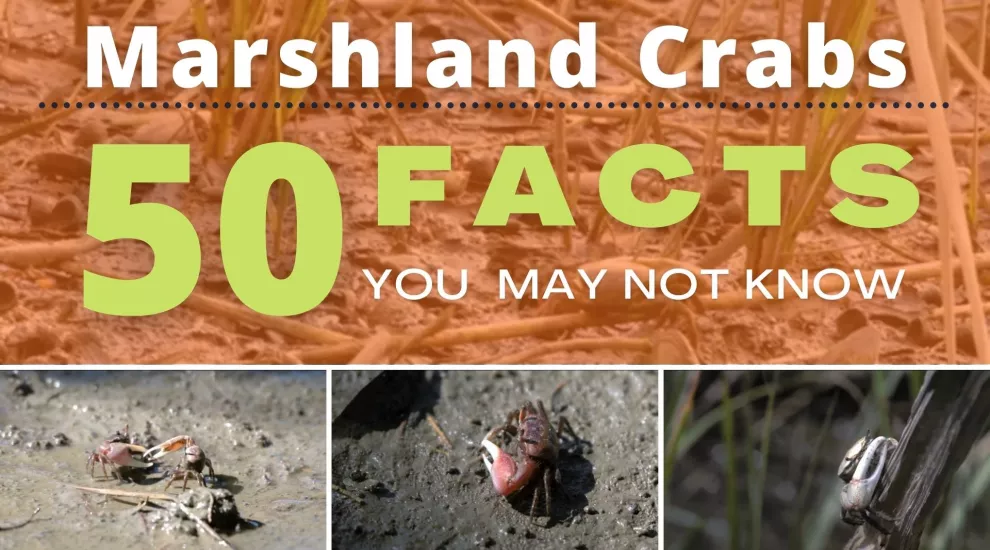
Crabs in the marshlands have played a crucial role off the coast of South Carolina for many centuries. Below, viewers may be shocked at the many different traits these creatures have to offer to their environment.
Marshlands are wetlands that are dominated by grasses and non-wooded plants that arise above the water. They are often seen throughout the edges of water streams, lakes, and off the coast of ocean water. In South Carolina, marshlands are commonly found throughout the Palmetto State’s coast in places such as Hunting Island State Park.
Marshland crabs come from the crustacean family, a series of creatures that are well known for their pincers and are common around the tropics and shores throughout the world.
In specific terms about marshland crabs and their importance to South Carolina, here are 50 things to know about marshland crabs the next time you come around to them!
General Information
Marshland crabs are found throughout South Carolina’s half a million acres of marshland, which is more than any other state on the east coast.
The marshland crabs are part of a rich and diverse ecosystem of animals that resides throughout the state’s marshlands.
In the environment, the crabs help remove toxicants from all around to help the marshes thrive.
Marshland crabs live in a saltwater environment in which the marshlands are located right off the Atlantic Ocean.
Several crabs are captured each year due to fishing and crabbing, which makes the creatures valuable to South Carolina’s fishing industry.
Marshland crabs in the marshes of South Carolina are harvested as seafood and sent to multiple restaurants across the country.
The most familiar places crabs can be found in the marshlands are either on spartina grass or pluff mud.
Marshland crabs are responsible for starting a food web that extends throughout the marshlands.
There are two popular types of marshland crabs that reside in South Carolina.
Marshland crabs play a pivotal role in the diverse and rich ecosystem of the marshlands.
The greatest threat to the crabs is pollution from nearby cities.
The South Carolina Department of Natural Resources have set up programs to help protect the animals.
Ships such as the Silver Crescent are sent out to check on the crabs’ health and water quality.
Their shell grows to one inch wide across their body.
Some of their most notable body features include the presence of two teeth on each side of their shell and hairy joints on their legs.
Marshland crabs can take the form of many assorted colors.
Marshland crabs can produce acoustic traits in their personality.
Female marshland crabs can carry up to as many as 13,000 eggs at once during the crabs’ life cycle.
Females can breed up to five times during her lifestyle.
Male crabs can make “rap sounds” when defending their burrows against other animals and creatures.
Marshland crabs in some cases can over-eat the grass that is in a marshland.
Fiddler Crab
Fiddler crabs are well known for having a “violin-style” claw.
Fiddler crabs are sexually dimorphic, meaning males only have the “violin-style” claw.
They are called Fiddler crabs because of this difference.
Their claws can grow up to as long as two inches.
The claw is used in two forms and purposes.
The first is to attract female crabs they are interested in.
The second is to use it against other male crabs they deem as a threat.
Fiddler crabs use and create burrows that reach several feet underground.
The purpose of the burrow for crabs is to mate and seek protection from predators.
Male Fiddler crabs produce tapping sounds when mating with female ones.
All Fiddler crabs are in the same shape and size.
Tier eyes are located at the end of two long eyestalks between the center of the carapace.
Fiddler crabs live in a colonial lifestyle even though a lot of them live close together.
Fiddler crabs travel in groups when it comes to eating and finding prey.
Squareback Marsh Crab
Squareback marsh crabs have the nickname of “Wharf Crabs.”
They are known for their daring approach when evading elements.
The best trait of squareback marsh crabs is their ability to climb trees.
Their main hobby is eating tiny insects seen throughout the marshlands.
Squareback marsh crabs also eat vegetation off the forest floor.
Colors of the squareback marsh crab can range from brown to olive.
Squarebacks have a tooth or spine that is located behind the crab’s eye socket.
Squareback marsh crabs do not need seawater to survive.
Water is required for them though so that oxygen can go across its gills.
Squareback marsh crabs are also true terrestrial crabs.
Squareback marsh crabs are often deemed detritivores, even though they are truly omnivorous.
They often prefer plants that are softer to eat instead of tougher ones.
Their diet consists primarily of what is found around them in the marshland environment.
Squarebacks are well known to blend in within their environment.
They must rely on drag powered swimming to get to certain places in the marshland.
For more information about marshland crabs, be sure to look at our What’s Wild episode on them, where we take a more digitalized look.





